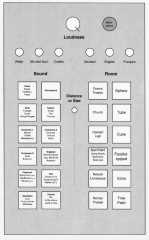Media Files
- › Paper_AML_1999 [PDF | 1 MB ]
- › Experimental setup for room impulse measurement [JPEG | 9 KB ]
- › Implementation of the basic shape "Free Field" [JPEG | 17 KB ]
- › Implementation of the basic shape "Cylinder" [JPEG | 21 KB ]
- › Paper_Christian Müller-Tomfelde: Low-latency convolution for real-time applications. 1999 [PDF | 211 KB ]
- › Paper_Davide Rocchesso, Pierre Dutilleux: Generalization of a 3-D Acoustic Resonator Model for the Simulation of Spherical Enclosures. 2001 [PDF | 423 KB ]
Technical Description
SCIENTIFIC AND TECHNICAL DETAILS
A very important factor for designing such an installation, was the definition of the desired sound results. Its main goal was to present different sounds with a room information associated, and even more important was that the rooms should be distinctive from each other. Different algorithms process the room reverberation in real-time from the original recorded dry sounds. For the Complex Shapes, the AML uses the Spatialisateur, a reverberation software developed at IRCAM-Espaces Nouveaux since 1992. Since this reverberation software runs only on a graphical programming environment called Max/MSP, the AML was programmed in this environment. Using this system, it solves the compromise between interactivity (it works in real-time) and good sound quality (it performs an accurate room imitation). The Basic Shapes use simpler algorithms developed by Pierre Dutilleux. These algorithms are based on Feedback Delay Lines that are tuned to produce specific time and frequency patterns.
To get an imitation of a Complex Shape within the AML, several steps have to be performed. The first is to measure the room Impulse Response, which contains the roomís reverberation pattern. A system with a loudspeaker and a measuring microphone is set up in the room. Then a MLSbased (Maximum Sequence Length) software measures the room Impulse Response, which describes the room reverberation between the sound source and the microphone position. These scientific measurements are converted to parameters that configure the reverberation algorithm Spatialisateur in a very specific way. It aims to imitate the room Impulse Response artificially. The AML software is reconfigured each time a room is selected and a distance modification can be performed in real-time.
It is also necessary to explain which phenomenon is exactly reproduced when listening to a sound in these imitated rooms. The sounds in the AML are considered as a punctual monophonic source, since the measurements of the room Impulse Responses are mono. This fact produces paradoxical situations such as putting a whole orchestra within a shoe-box inside the room. The AML plays the orchestra sound as a punctual source and not distributed along the stage. An accurate reproduction of a virtual scene could be called as virtual simulation, but it is not the objective of the AML. For some of the dry sounds in the catalogue, which are mono-source sounds (Voice, Solo, ...) or also for the visitorís voice, the AML imitates exactly the real situation of having a unique sound source at the corresponding distance. A binaural conversion allows to have the same space impression when using headphones as reproduction set.
The System Requirements of this version are: Macintosh PowerMac G4 450 MHz, a screen with resolution 1024 x 768 pixels, microphone and headphones.
(Jordi Janer and Pierre Dutilleux)


